
06 Jun The Potential of Video in B2B Marketing
Video marketing is the “in thing” in B2B marketing today. Multiple stakeholders and decision makers can be reached effectively through strategically produced videos having the right content and placed in the right channel. Here’s a look at why businesses need to seriously consider budgeting for video marketing.
Relevance of videos continues
The marketing revolution that TV commercials brought in decades ago has found a new trajectory with the advent of Internet and smartphones. Video viewing has never been higher and people are consuming more than a billion hours of video content every day. As of 2022, an average person is predicted to spend 100 minutes per day watching online videos; and including a video on the landing page can boost conversion rate by up to 80%. Also, over 90% of B2B customers are now watching videos online and nearly half of these customers are watching videos for researching products or services. These are statistics that marketers cannot ignore, and therefore are looking at videos as their top marketing strategy.
Hesitancy among B2B Marketers?
However, many B2B marketers feel that videos are more B2C and are hesitant about using them. They are also impeded by limited budgets, complex production processes, and a lack of understanding on how to integrate video into their overall marketing strategy. They also feel that since everybody is doing it, is it still effective?
The answer is a big resounding YES! They are effective and there are viable solutions to all the above problems and B2B companies can benefit significantly by using video marketing strategically and in the right manner.
B2B marketers can use multiple types of videos, such as social media videos, educational and interactive videos, how-to videos, videos that included user-generated content, behind-the-scenes videos, and Live stream video. Also, since customers have access to multiple channels, videos can be strategically integrated at each of these points for optimum returns. For example:
- On B2B landing Page: Use actionable and relevant video to explain the potential benefits of your product.
- B2B Social-Media Pages: Use videos in social media pages to get more engagement, especially on Facebook, Instagram, Twitter and even LinkedIn.
- B2B Email Marketing Campaigns: Send a series of video emails to targeted accounts using CRM to build and nurture leads.
- Live video streaming: This is a very common strategy where the business uses live video streaming to showcase virtual events, new product launches, and hold Q&As sessions online. Since this can be done through a mobile device or a webcam, it’s one of the most inexpensive yet effective types for user engagement.
However, the recipe for a sticky and effective video is to:
- Optimize for mobile viewing
- Keep it short—not more than 2 minutes—to get more engagement. Except for case studies or in-depth how-to videos where longer videos work well, in general, shorter videos are more effective.
- Build curiosity to drive viewer to watch the next video
There is no doubt that video content can give a very high ROI for B2B brands. For those just about to explore video marketing, start slow and easy, and try to integrate video customer reviews featuring real stories from real buyers. In the long run, a sustained video marketing strategy can improve customer engagement and retention rate, support SEO, blogging, social media, and other marketing efforts, and help reach clients at different points in the B2B sales cycle.






No Comments